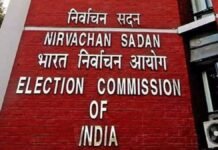
Key Points:
- Phase 1 campaigning ends today (November 4); voting November 6 for 121 constituencies
- Tejashwi promises ₹30,000 lump-sum transfer to women under Mai-Behan Yojana (vs Nitish’s ₹10,000)
- Free electricity for farmers’ irrigation; ₹300/quintal bonus on paddy, ₹400/quintal on wheat MSP
- PACS workers to receive public representative status and honorarium benefits
- Phase 2 polling November 11; results declared November 14
- NDA: BJP 80 seats, JD(U) 45, others 6; Mahagathbandhan: RJD 77, Congress 19, Left 15
- 7.42 crore voters across 90,712 polling stations
Patna: As campaigning for Bihar’s 243-seat assembly election enters its final hours today, the Mahagathbandhan alliance led by Tejashwi Yadav has unleashed a barrage of electoral promises designed to shift momentum in the opposition’s favor. With the first phase of voting scheduled for November 6 across 121 constituencies, the RJD leader has pivoted to direct cash transfers and agricultural subsidies promises that appear calibrated to counter the governing coalition’s welfare initiatives while energizing key voter blocs ahead of the voting.
Women’s Welfare: The ₹30,000 Counter-Gambit
Chief Minister Nitish Kumar, seeking his unprecedented ninth term in power, initiated the welfare arms race early in campaigning by transferring ₹10,000 from the Chief Minister Women’s Employment Scheme into the accounts of female beneficiaries. This maneuver was widely perceived as the NDA’s dominant electoral move, a tangible, immediate benefit that could sway millions of women voters.
Tejashwi Yadav responded decisively on the campaign trail, announcing that if the Mahagathbandhan forms the government, women will receive an even more substantial ₹30,000 annual allocation under the Mai-Behan Yojana (Mother-Sister Scheme). Critically, Tejashwi pledged that this entire sum would be transferred to women’s bank accounts in a single lump-sum deposit on January 14, immediately following government formation. This promise, three times larger than Nitish’s offer, represents a calculated attempt to neutralize the NDA’s women-focused strategy while positioning the opposition as more generous and attentive to women’s economic needs.
Political analysts view this move as particularly significant because women comprise roughly half the 7.42 crore registered voters in Bihar. With women demonstrating stronger voting participation rates than men in recent Indian elections, this demographic’s allegiance could prove decisive in determining which coalition forms the next government.
Agricultural Revolution: Free Electricity and MSP Bonuses
Recognizing that farmers constitute another crucial voting bloc, Bihar’s rural population exceeds 90% Tejashwi announced a multifaceted agricultural support package. The centerpiece involves providing free electricity for irrigation, directly addressing a core farmer grievance. Currently, Bihar charges farmers 55 paise per unit for irrigation electricity; under the proposed scheme, this rate would become zero.
Additionally, Tejashwi committed to providing cash bonuses on top of minimum support price (MSP) rates: ₹300 per quintal for paddy and ₹400 per quintal for wheat. These bonuses would supplement, not replace, existing MSP payments, effectively increasing farmer revenues by 15-20% depending on crop yields and pricing conditions. Given that millions of Bihar’s farmers operate on razor-thin profit margins, this promise represents tangible economic relief from a consistent source of rural discontent.
PACS Empowerment: Elevating Cooperative Workers
In a move targeting the political consciousness of rural India’s cooperative and trading establishment, Tejashwi announced that all Primary Agricultural Cooperative Societies (PACS) and trade boards in Bihar would be granted the status of public representatives under a Mahagathbandhan government. Complementing this, the RJD leader proposed that workers employed in the state’s 8,463 PACS would receive honorarium payments from the Cooperative Department, a benefit structure that would elevate and recognize their professional standing while providing direct income.
This initiative serves multiple political purposes: it institutionalizes rural cooperative systems within formal governmental frameworks, provides income security for approximately 200,000+ cooperative workers statewide, and addresses a persistent complaint that agricultural workers remain economically vulnerable and professionally undervalued. The political significance lies in Bihar’s agricultural cooperative networks’ deep roots in rural communities—bestowing official status and compensation on these workers could mobilize a previously overlooked constituency.
Election Mathematics: A Tight Four-Way Contest
The Bihar election involves multiple competing alliances and independent formations. The National Democratic Alliance (NDA) currently holds 131 of 243 seats: BJP 80, Janata Dal (United) 45, Hindustani Awam Morcha (Samrat Choudhary faction) 4, and two Independents. The Mahagathbandhan controls 111 seats: Rashtriya Janata Dal (RJD) 77, Indian National Congress 19, CPI(ML) 11, CPI(M) 2, and CPI 2. The remaining seat is held by independent candidates.
This configuration leaves 101 seats open for redistribution, a substantial number that could determine governmental control. Notably, new entrants like Prashant Kishor’s Jan Suraaj party, the Aam Aadmi Party (AAP), and the All India Majlis-e-Ittihad-ul-Muslimeen (AIMIM) have entered the race, potentially fragmenting traditional voting patterns.
The Nitish Credibility Crisis
Despite seeking a record ninth term, Nitish Kumar faces significant credibility headwinds. Since 2017, he has switched alliances four times—leaving and rejoining the NDA in 2022, departing the Mahagathbandhan in January 2024, then returning to NDA governance. This pattern of political volatility has eroded voter confidence in his commitment to any particular coalition or governance philosophy.
Additionally, the Special Intensive Revision (SIR) voter list exercise conducted before these elections generated substantial opposition criticism, though the Election Commission maintained procedural transparency. These factors create an opening for an opposition narrative positioning Tejashwi as a principled alternative to Nitish’s perceived inconsistency.
High-Voltage Campaign Finale
The final campaign day has witnessed unprecedented intensity. Prime Minister Narendra Modi conducted 8 separate election meetings on Monday, including rallies and a roadshow through Patna. He is scheduled today to interact with women workers of the BJP’s grassroots organization under the Mera Booth Sabse Majboot (My Booth is Strongest) initiative, a direct counter to Tejashwi’s women-focused messaging.
Union Home Minister Amit Shah, Congress President Mallikarjun Kharge, and Congress General Secretary Priyanka Gandhi have similarly saturated the campaign landscape with coordinated messaging. The concentration of national leadership at Bihar’s grassroots level underscores the state’s political significance and the genuine competitive uncertainty characterizing this election.
Voting Schedule and Electoral Architecture
Phase 1 voting for 121 constituencies will proceed on November 6 across 18 districts. Phase 2 voting for the remaining 122 constituencies follows on November 11. Vote counting will occur simultaneously for both phases on November 14, with official results announced the same day. Election authorities have deployed over 90,000 polling stations accommodating 7.42 crore registered voters, including 3.92 crore men, 3.50 crore women, 14 lakh first-time voters, and 14,000 voters exceeding 100 years old.
The Election Commission has implemented upgraded security protocols, including one General Observer per constituency (a first-time measure), webcasting at all polling stations, intensified Central Armed Police Force deployment, and strict vigilance against illegal drug, cash, and liquor movement across state boundaries.
The Verdict and Implications
The Tejashwi promises represent a calculated political gamble. If the Mahagathbandhan wins and implements these schemes, the opposition leader transforms from an electoral challenger into a governance administrator capable of delivering material benefits. Conversely, if the NDA retains power, Nitish must either match these promises or accept criticism of insufficient welfare commitment, a difficult position given his government’s fiscal constraints.
The election ultimately hinges on whether rural voters prioritize incremental welfare improvements (Nitish’s strategy) or seek transformative economic restructuring (Tejashwi’s positioning). With voting beginning in 48 hours and a crowded political landscape, the 7.42 crore Bihar voters will determine whether this electoral arithmetic produces surprise and disruption or reaffirms incumbent stability.


















































